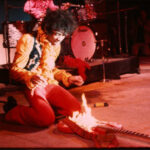Jerry Garcia, the legendary guitarist of the Grateful Dead, was as renowned for his distinctive guitar playing as he was for his improvisational mastery. For Garcia, guitars were more than just instruments; they were partners in his musical journey, each with its own unique story and sonic character. Throughout his illustrious career, Garcia amassed a collection of remarkable guitars, but a select few rose to iconic status, becoming synonymous with his sound and legacy. This article explores the most celebrated Jerry Garcia Guitars, delving into the history, modifications, and impact of these exceptional instruments.
“He slept with these instruments.” – Steve Parish on Jerry’s profound connection with Jerry Garcia’s guitars.
Alligator: The Early Days Stratocaster
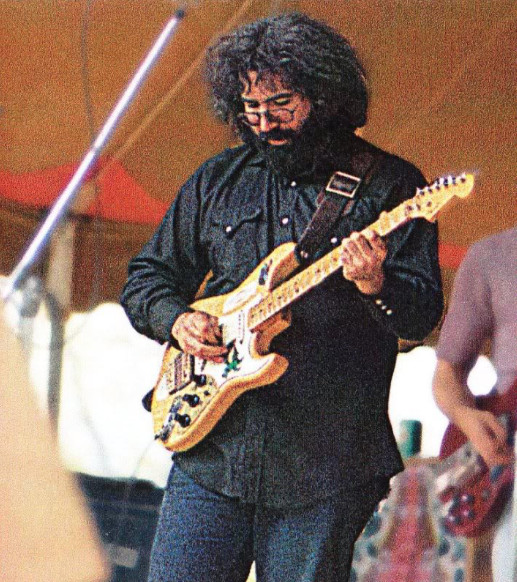 Jerry Garcia's "Alligator" guitar, a customized 1957 Fender Stratocaster, showcasing its worn finish and distinctive stickers.
Jerry Garcia's "Alligator" guitar, a customized 1957 Fender Stratocaster, showcasing its worn finish and distinctive stickers.
In the Grateful Dead’s formative years, Jerry Garcia’s guitar choices were dictated by availability and affordability. During this period of experimentation and growth, he played a variety of guitars as the band honed their signature sound. It was during these early days that a pivotal instrument entered Garcia’s life: the “Alligator.” This guitar, a 1957 Fender Stratocaster, was gifted to Garcia by Graham Nash, marking the beginning of a significant chapter in his guitar history. Used extensively between 1970 and 1973, the Alligator quickly became a favorite.
The Alligator was far from a standard Stratocaster. It underwent numerous modifications at the hands of Frank Fuller and Rick Turner of Alembic Guitars. These luthiers transformed the guitar, earning it the nickname “Frankenstein” due to the constant alterations. Modifications ranged from pickup changes to neck adjustments, reflecting Garcia’s evolving sonic preferences and the Alembic team’s innovative spirit. The final modification occurred in August 1973, and its last documented live performance was on Garcia’s birthday, August 1, 1973. Today, the Alligator is carefully preserved in the Jerry Garcia archives, a testament to its historical importance.
Wolf: The Custom Doug Irwin Original
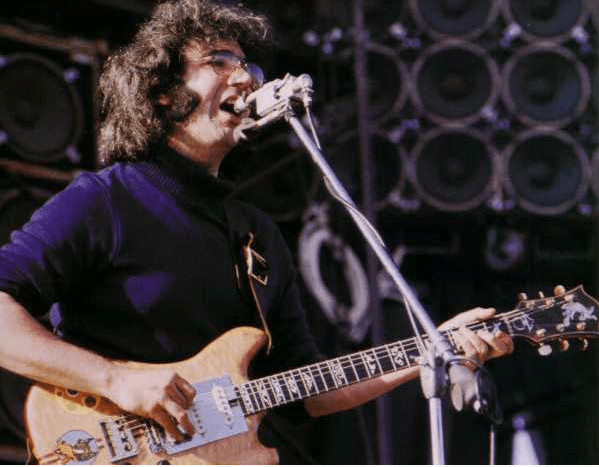 Jerry Garcia playing his custom-built "Wolf" guitar, crafted by Doug Irwin, featuring its distinctive wolf inlay and purpleheart body.
Jerry Garcia playing his custom-built "Wolf" guitar, crafted by Doug Irwin, featuring its distinctive wolf inlay and purpleheart body.
Garcia’s relationship with Alembic Guitars led him to another pivotal figure in his guitar story: luthier Doug Irwin. Impressed by Irwin’s craftsmanship, Garcia commissioned a custom instrument, leading to the birth of “Wolf.” Wolf made its debut on September 5, 1973, at a private Hell’s Angels party with Merl Saunders, instantly capturing attention with its unique design and sound. Initially adorned with a peacock and then Irwin’s eagle logo, it was a wolf sticker, applied by Garcia himself, that ultimately defined the guitar’s identity and gave it its iconic name. Irwin later integrated the wolf motif into the guitar’s design.
Constructed from purpleheart and curly maple, Wolf boasted an ebony fingerboard and 24 frets, designed for Garcia’s expansive playing style. Primarily used throughout the 1970s, Wolf briefly resurfaced in 1989 for MIDI experiments and made its final stage appearance with Garcia in 1993. Following a legal dispute, Irwin regained ownership of Wolf and auctioned it in 2002 for a staggering $700,000. Since then, Wolf has continued to make appearances, played by artists like Warren Haynes during his Jerry Garcia Symphonic Celebration tours, and by Tom Hamilton of JRAD and members of Dark Star Orchestra, ensuring its legacy lives on.
Travis Bean TB500: Aluminum Neck Innovation
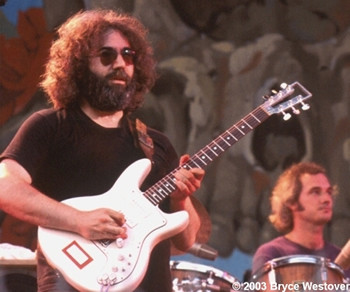 Jerry Garcia playing his Travis Bean TB500 #12 guitar, recognizable by its aluminum neck and minimalist design.
Jerry Garcia playing his Travis Bean TB500 #12 guitar, recognizable by its aluminum neck and minimalist design.
A departure from traditional wood construction, the Travis Bean TB500 #12 guitar marked a unique phase in Garcia’s instrument journey. Debuted on December 31, 1976, at a Grateful Dead show at the Cow Palace, this guitar was notable for its aluminum neck, contributing to a bright, resonant tone. Garcia played this TB500 in over 90 shows in the late 1970s, including the Grateful Dead’s legendary 1977 Winterland Ballroom performances and during the recording of the album Terrapin Station.
According to Steve Parish, Jerry Garcia’s longtime roadie, the TB500 was Garcia’s third-most-played guitar, only surpassed by “Tiger” and “Wolf.” A humorous sticker, “Ass, Grass or Gas/Nobody Rides Free,” covered an earlier sticker, “The Enemy is Listening,” reflecting Garcia’s playful personality. The TB500 era ended when Garcia received his new “Tiger” guitar from Doug Irwin in the late 70s, but its contribution to the Grateful Dead’s sound during a pivotal period remains significant. In 2013, this historical instrument was sold at auction, further solidifying its place in guitar history.
Tiger: Doug Irwin’s Masterpiece
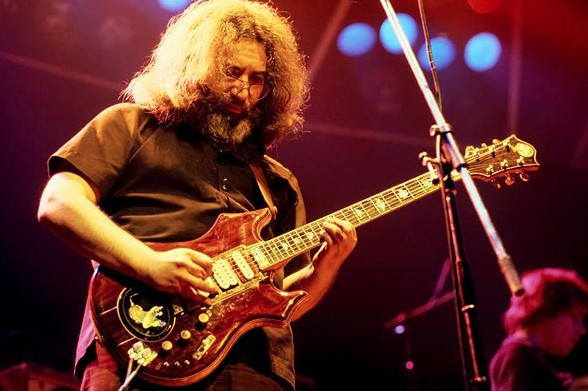 Close-up of Jerry Garcia's "Tiger" guitar, highlighting its intricate tiger inlay, layered wood construction, and distinctive hardware.
Close-up of Jerry Garcia's "Tiger" guitar, highlighting its intricate tiger inlay, layered wood construction, and distinctive hardware.
Following the creation of Wolf, Jerry Garcia challenged Doug Irwin to create an even more exceptional instrument, with no limitations on time or cost. The result was “Tiger,” a guitar that took Irwin six years to build and became arguably the most iconic of all Jerry Garcia guitars. Featuring a “hippie sandwich” construction of various wood types layered together, and a distinctive tiger inlay, Tiger was a true masterpiece. Weighing a substantial 13.5 lbs, Tiger was known for its tonal versatility. Garcia himself described it as having “twelve discreet possible voices,” praising its wide range of tones achievable through its electronics and his playing technique, particularly using the middle pickup.
First played on August 4, 1979, in Oakland, Tiger became Garcia’s primary guitar throughout the 1980s. In a poignant turn of events, despite primarily using “Rosebud” in the 1990s, it was Tiger that Garcia played during the Grateful Dead’s final performance on July 9, 1995, after Rosebud malfunctioned. Thus, Tiger holds the distinction of being the last guitar Jerry Garcia ever played on stage. After Garcia’s passing, Tiger was part of a legal settlement with Doug Irwin and was auctioned in 2002 for $850,000 to Jim Irsay, owner of the Indianapolis Colts and a noted guitar collector. Irsay facilitated Tiger’s return to the stage in 2016, played by Warren Haynes at Red Rocks Amphitheatre on what would have been Garcia’s 74th birthday, a fitting tribute to the guitar and its legendary player.
Rosebud: The MIDI-Equipped Twin
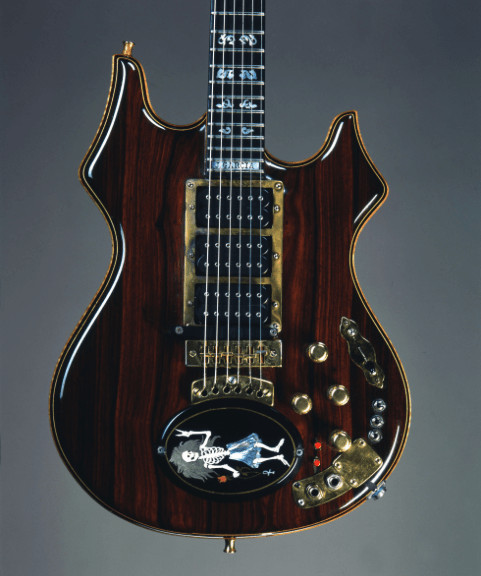 Jerry Garcia's "Rosebud" guitar, showcasing its similar body shape to Tiger but with a lighter construction and MIDI controls.
Jerry Garcia's "Rosebud" guitar, showcasing its similar body shape to Tiger but with a lighter construction and MIDI controls.
Continuing his collaboration with Doug Irwin, Jerry Garcia commissioned “Rosebud” in the late 1980s, seeking to incorporate the advancements in guitar technology of the era. Conceived as a spiritual twin to Tiger, Rosebud included built-in MIDI controls, reflecting Garcia’s exploration of new sonic territories. Despite its visual similarities to Tiger, Rosebud was lighter, weighing two pounds less due to its hollowed maple core. Garcia made minimal modifications to Rosebud throughout its use, primarily experimenting with pickup swaps. The inlay, initially called “The Saint,” was affectionately renamed Rosebud by Garcia.
Rosebud debuted on New Year’s Eve 1989, marking the start of a new decade and a new guitar era for Garcia. It became his primary instrument in the early 1990s until the arrival of “Lightning Bolt” in 1993. However, when Lightning Bolt was undergoing repairs in the summer of 1995, Rosebud returned to service, becoming the guitar Garcia played on his final tour. Notably, it was Rosebud that resonated the second-to-last song he ever performed, “Black Muddy River.” Rosebud’s final resting place is the Rock and Roll Hall Of Fame, where it is preserved for posterity.
Lightning Bolt: The Yacht Builder’s Creation
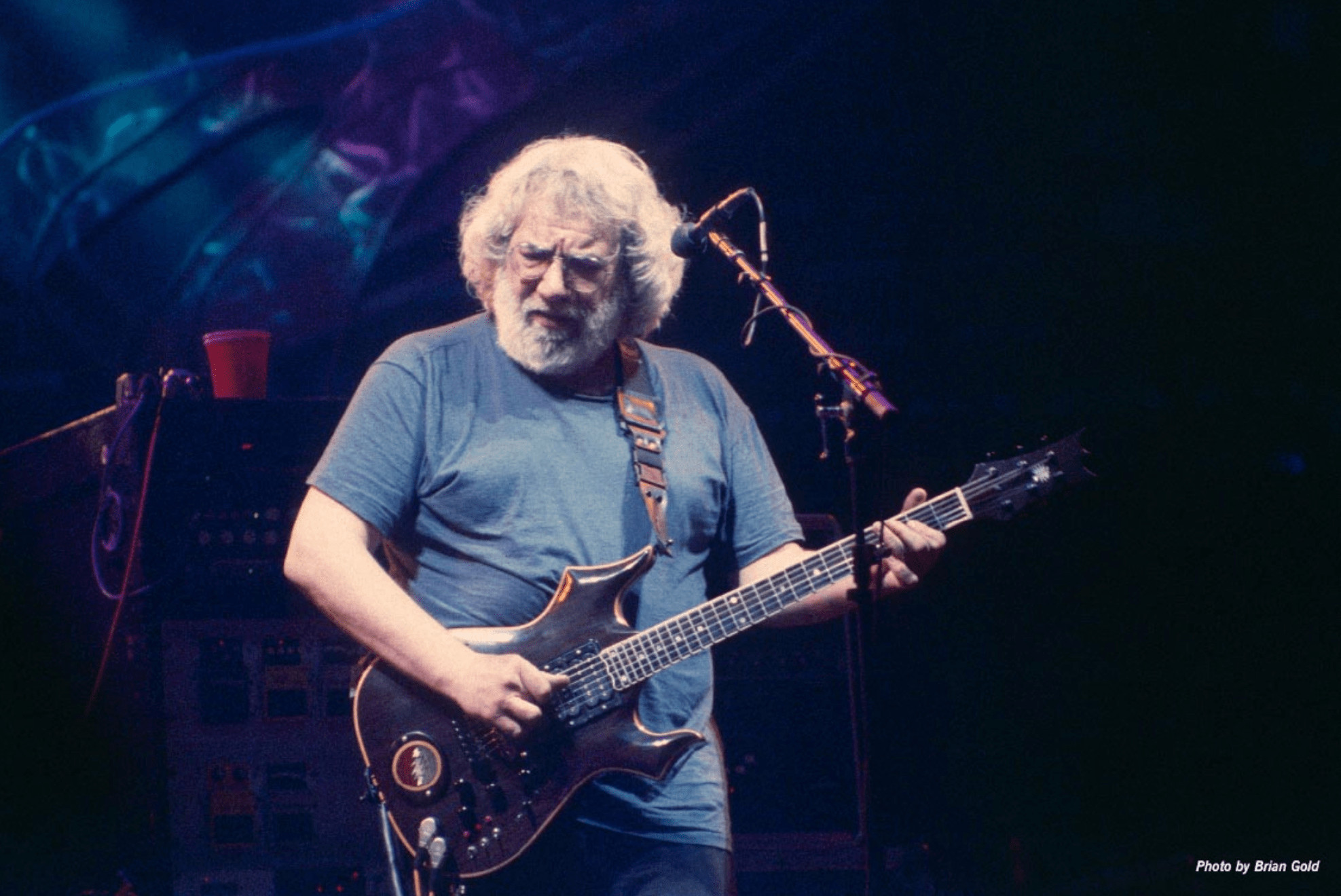 Jerry Garcia's "Lightning Bolt" guitar, crafted by Stephen Cripe, featuring its unique lightning bolt inlay and distinctive body shape.
Jerry Garcia's "Lightning Bolt" guitar, crafted by Stephen Cripe, featuring its unique lightning bolt inlay and distinctive body shape.
“Lightning Bolt” represented a departure from Doug Irwin’s creations, crafted instead by yacht builder Stephen Cripe. Cripe meticulously studied footage of Garcia playing Tiger in the “Dead Ahead” video to create a guitar that captured its essence while adding his own stylistic touches. He sent the guitar to Garcia, who was immediately captivated. The use of reused rosewood for the fingerboard resonated with Garcia’s conservationist values, and the design offered enhanced access and comfort in the higher registers of the neck. Cripe also designed the striking lightning bolt inlay that gave the guitar its name.
Garcia first played Lightning Bolt on August 7, 1993, with the Jerry Garcia Band. Initially, the guitar lacked MIDI compatibility, which was quickly rectified by repairman Gary Brawer to meet Garcia’s technical requirements. Later, a bridge replacement sidelined Lightning Bolt, causing it to miss the Grateful Dead’s final tour. Its last performance was on June 4, 1995, at the Shoreline Amphitheater. Like Rosebud, Lightning Bolt is now housed in the Rock and Roll Hall Of Fame, preserving its legacy.
These five Jerry Garcia guitars represent more than just instruments; they are artifacts of musical history, each embodying a distinct era of the Grateful Dead and Jerry Garcia’s evolving sound. From the early days of Alligator to the sophisticated designs of Rosebud and Lightning Bolt, each guitar tells a story of innovation, collaboration, and the deep connection between a musician and his tools. While Jerry Garcia’s physical presence is missed, his musical legacy, amplified by these remarkable guitars, continues to resonate.
[Photos and information via from Jerry Garcia’s website]

